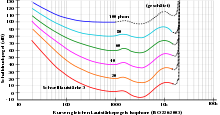Aurally correct volume
The term aurally correct volume or aurally correct volume equalization describes how sound recordings are reproduced in such a way that they produce a similar auditory impression at different volumes .
The first data on "aurally accurate volume" were collected in 1933 by Fletcher-Munson. The "psychoacoustic curves of the same volume level" were specified in ISO Recommendation R226 (R454) and DIN 45630 Bl.2 (DIN 1318) according to Robinson-Dadson. The current data are defined in ISO 226: 2003; they differ from the previous standards. One of the reasons for the changes is that the hearing impression is subjective and the data on which the standardization is based is obtained by averaging over many people with different hearing impressions.
Perception of different volume levels
The volume perception is strongly frequency-dependent. The dependence of volume perception on frequency is also different for different volume levels.
The figure on the right shows the frequency dependency of volume perception for different volumes, i.e. what sound pressure level sine tones of different frequencies must have so that they are perceived equally loud. At a (perceived) volume level of 80 Phon , for example, a 50 Hz tone with approx. 100 dB must have a sound pressure level that is approx. 20 dB higher than a 1 kHz tone that is perceived as equally loud with approx. 80 dB . The sound pressure level of a 10 kHz tone perceived to be equally loud is approx. 92 dB, about 12 dB above that of the 1 kHz tone and about 8 dB below that of the 50 Hz tone.
Principle of aurally accurate volume equalization
If music is mixed for an original volume level of 80 Phon so that it sounds good there, the properties of the hearing for this level are included in the recording. If this music is now played at a volume level of 40 phon, the settings for 80 phon recording are no longer correct. In other words, in order to achieve a sound similar to the original recording, the bass and treble would have to be increased.
Circuits for aurally correct volume equalization or loudness buttons in amplifiers should correct the frequency response accordingly in order to achieve a sound similar to the original volume when played back at low volumes.
Technical design
When reproducing noises via loudspeakers or headphones , a plausible, balanced hearing should be conveyed. Due to the almost free choice of the playback level, an unpleasant impression can easily arise if the change from the original level results in a change in the color of the sound or if individual sound components even disappear due to the level-dependent masking .
In order to enable a reproduction of all frequencies corresponding to the original noise, both with loud and with the amplifier set to low, many amplifiers are equipped with different circuits that are intended to effect aurally correct volume equalization. The frequency response of the presented noise is adapted to the playback level. Usually this feature is turned on by pressing a button labeled loudness or contour . However, this function is only of limited use, since the adaptation is usually designed to be very simple and the applicability of the curves of the same volume level (isophones) to complex signals is at least controversial. In addition, there is no adaptation to the respective type of noise and the listening location.
The assumption that highs and lows need to be raised equally is controversial. In the diagram according to ISO 226: 2003, the isophones (lines of equal volume) run almost all parallel at frequencies greater than 1 kHz, so only the level of the low frequencies would have to be increased in the case of quiet playback.
literature
- Hubert Henle: The recording studio manual . 5th edition, GC Carstensen Verlag, Munich, 2001, ISBN 3-910098-19-3
- Thomas Görne: Sound engineering . 1st edition, Carl Hanser Verlag, Leipzig, 2006, ISBN 3-446-40198-9
Web links
- "Aurally correct" volume control and hearing sensitivity (PDF file; 135 kB)
- Curves of equal volume level - Fletcher-Munson is not Robinson-Dadson (PDF file; 291 kB)
- Precise and Full-range Determination of Two-dimensional Equal Loudness Contours (PDF file; 191 kB)
- Normal equal-loudness-level contours - ISO 226: 2003 Acoustics (PDF file; 28 kB)
